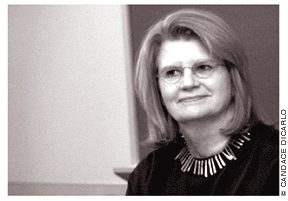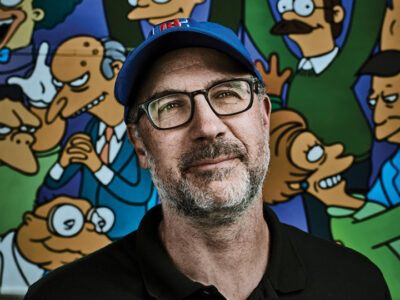
“I’m glad you didn’t say I was a former teacher,” noted cable TV pioneer Geraldine Laybourne GEd’71 at the start of a question-and-answer session she gave at the Graduate School of Education during a recent campus visit.
GSE Dean Susan Fuhrman had just finished tracing Laybourne’s career path from student teaching to head of the cable network Nickelodeon to her current position as founder and CEO of the Oxygen Network, a TV network and website for “smart women [who] need a place to have fun,” which is currently available in 51 million U.S. households.
Fuhrman did call Laybourne a “role model for an education background.” Teaching, Laybourne said, “changes the way you look at things,” and provides excellent training for “creating organizations about learning” in a business environment in which “information exchange has never been faster, and market conditions never more difficult.”
Laybourne described her training at GSE as characterized by careful observational research and an emphasis on making education fit the individual, finding a “window into” learning for each child. This outlook shaped her management philosophy at Nickelodeon and the network’s programming approach. Her own favorite TV personality, she said, was Mr. Rogers, “as doofusy as he was.” Nick tried to provide that same sense of specialness Fred Rogers gave to young viewers, but “in a hipper way.”
At Nickelodeon, Laybourne launched shows like Rugrats, Ren and Stimpy, Doug, and Nick News. She fondly recalled the “open, creative environment” at the fledgling network, in which the staff was “driven by a mission to do something great for kids.” The process involved “a lot of brainstorming with the entire company,” she said, “talking about what’s working, what’s not.” Her own role was as an “amalgamator” of those ideas.
Not that Nick hasn’t had its share of missteps. In the network’s early days, she said, it was initially “very earnest.” She cited a show called We’re Going Great that profiled various “fantastic kids” and was aimed at inspiring young viewers—but left the ones in focus groups “devastated” and feeling like “that’s another thing I won’t be able to do.” It was soon replaced by programming featuring green slime, silly jokes, and shows like You Can’t Do That on Television, which provided kids with “horrible role models,” like teachers who “put them in dungeons,” leading young viewers to conclude that “my principal’s not too bad.”
After Nickelodeon, Laybourne moved to Disney/ABC, and in 1998 she joined with Oprah Winfrey and Carsey-Warner-Mandabach to launch Oxygen, a cable network and website for younger women. She contrasted it wryly to the Lifetime Channel—designed for “all these old has-beens” of her own generation: “We go there, and we sob, and it’s very rewarding,” she said to appreciative laughter from the audience.
The Oxygen target audience of women in their 20s and 30s represents a “very different psychographic,” she said; they are “women who feel confident and happy and like the fact that they have to juggle kids, work, relationships.”
These women “have a lot of stuff on their minds” and enjoy blowing off steam with programs like Talk Sex, which offers advice from 70-year-old “sex educator” Sue Johanson, and the hidden-camera show Girls Behaving Badly.
Asked to reflect on lessons learned from Oxygen’s closely watched debut, Laybourne offered three. First, she said, given a choice, it is better to prepare to launch a project in secret, as was the case with Nickelodeon and decidedly not with Oxygen. That way, she explained, you can make your mistakes before anyone notices.
Second, they tried to do too much at the start. “Branding on two platforms—Internet and TV—had never been tried before,” and the two cultures did not mesh well. In retrospect, she said, “it would have been better to just do TV.” On the other hand, the investors—following the conventional wisdom of the dotcom mania then gripping the market—wanted to do just Internet, considering TV too “old media.”
Finally, she said, the experience showed her that, “you have to earn everything.” In the end, the reputations and high profiles of the project partners did not mean anything: “There are no short cuts.”
Laybourne, a veteran of the corporate days in which women presented themselves as “little men” and “even wore little bow ties,” regards the network as a training ground for women in business. “We have 220 employees and 70 babies,” she said, adding that Oxygen’s offices probably have “more lactation rooms” than any other company.
Of her own efforts to balance childraising and career during her rise through the corporate ranks, she joked that she was “doing kids TV” while her children were growing up. “My kids would be crying by the end of the weekend, ‘Please mom, no more TV!’” She also offered a few pieces of more transferable advice for working mothers. For instance, she would often talk on her cell phone with her son during her 25-minute drive home, work late to save the weekend for family time, and forbid work-related calls to her home, she said. “It’s basically a matter of putting your priorities straight —at the end of the day, that’s all that matters.”
—J.P.




